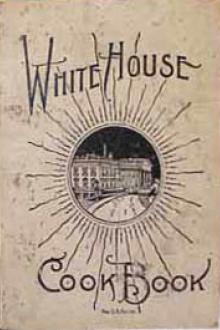The Whitehouse Cookbook (1887), Hugo Ziemann [world of reading .TXT] 📗

- Author: Hugo Ziemann
- Performer: -
Book online «The Whitehouse Cookbook (1887), Hugo Ziemann [world of reading .TXT] 📗». Author Hugo Ziemann
ENDIVE.
This ought to be nicely blanched and crisp, and is the most wholesome of all salads. Take two, cut away the root, remove the dark green leaves, and pick off all the rest; wash and drain well, add a few chives. Dress with "Mayonnaise dressing."
Endive is extensively cultivated for the adulteration of coffee; is also a fine relish, and has broad leaves. Endive is of the same nature as chicory, the leaves being curly.
CELERY SALAD.
Prepare the dressing the same as for tomato salad; cut the celery into bits half an inch long, and season. Serve at once before the vinegar injures the crispness of the vegetables.
LETTUCE SALAD.
Take the yolks of three hard-boiled eggs, and salt and mustard to taste; mash it fine; make a paste by adding a dessertspoonful of olive oil or melted butter (use butter always when it is difficult to get fresh oil); mix thoroughly, and then dilute by adding gradually a teacupful of vinegar, and pour over the lettuce. Garnish by slicing another egg and laying over the lettuce. This is sufficient for a moderate-sized dish of lettuce.
POTATO SALAD, HOT.
Pare six or eight large potatoes, and boil till done, and slice thin while hot; peel and cut up three large onions into small bits and mix with the potatoes; cut up some breakfast bacon into small bits, sufficient to fill a teacup and fry it a light brown; remove the meat, and into the grease stir three tablespoonfuls of vinegar, making a sour gravy, which with the bacon pour over the potato and onion; mix lightly. To be eaten when hot.
POTATO SALAD, COLD.
Chop cold boiled potatoes fine, with enough raw onions to season nicely; make a dressing as for lettuce salad, and pour over it.
BEAN SALAD.
String young beans; break into half-inch pieces or leave whole; wash and cook soft in salt water; drain well; add finely chopped onions, pepper, salt and vinegar; when cool, add olive oil or melted butter.
TO DRESS CUCUMBERS RAW.
They should be as fresh from the vine as possible, few vegetables being more unwholesome when long gathered. As soon as they are brought in lay them in cold water. Just before they are to go to the table take them out, pare them and slice them into a pan of fresh cold water. When they are all sliced, transfer them to a deep dish; season them with a little salt and black pepper, and pour over them some of the best vinegar. You may mix with them a small quantity of sliced onions, not to be eaten, but to communicate a slight flavor of onion to the vinegar.
CELERY UNDRESSED.
Celery is sometimes sent to the table without dressing. Scrape the outside stalks, and cut off the green tops and the roots; lay it in cold water until near the time to serve, then change the water, in which let it stand three or four minutes; split the stalks in three, with a sharp knife, being careful not to break them, and serve in goblet-shaped salad glasses.
To crisp celery, let it lie in ice-water two hours before serving; to fringe the stalks, stick several coarse needles into a cork, and draw the stalk half way from the top through the needles several times and lay in the refrigerator to curl and crisp.
RADISHES.
All the varieties are generally served in the same manner, by scraping and placing on the table in glasses containing some cold water to keep them fresh looking.
PEPPERGRASS AND CRESS.
These are used mostly as an appetizer, served simply with salt. Cresses are occasionally used in making salad.
HORSE-RADISH.
Horse-radish is an agreeable relish, and has a particularly fresh taste in the spring; is scraped fine or grated, and set on the table in a small covered cup; much that is bottled and sold as horse-radish is adulterated with grated turnip.
LETTUCE.
Wash each leaf separately, breaking them from the head; crisp in ice-water and serve the leaves whole, to be prepared at table, providing hard-boiled eggs cut in halves or slices, oil and other ingredients, to be mixed at table to individual taste.
CATSUPS.TOMATO CATSUP. No. 1.
Put into two quarts of tomato pulp (or two cans of canned tomatoes) one onion, cut fine, two tablespoonfuls of salt and three tablespoonfuls of brown sugar. Boil until quite thick; then take from the fire and strain it through a sieve, working it until it is all through but the seeds. Put it back on the stove, and add two tablespoonfuls of mustard, one of allspice, one of black pepper and one of cinnamon, one teaspoonful of ground cloves, half a teaspoonful of cayenne pepper, one grated nutmeg, one pint of good vinegar; boil it until it will just run from the mouth of a bottle. It should be watched, stirred often, that it does not burn. If sealed tight while hot, in large-mouthed bottles, it will keep good for years.
TOMATO CATSUP. No. 2.
Cook one gallon of choice ripe tomatoes; strain them, and cook again until they become quite thick. About fifteen minutes before taking up put into them a small level teaspoonful of cayenne pepper, one tablespoonful of mustard seed, half a tablespoonful of whole cloves, one tablespoonful of whole allspice, all tied in a thin muslin bag. At the same time, add one heaping tablespoonful of sugar, and one teacupful of best vinegar and salt to suit the taste. Seal up air-tight, either in bottles or jugs. This is a valuable Southern recipe.
GREEN TOMATO CATSUP.
One peck of green tomatoes and two large onions sliced. Place them in layers, sprinkling salt between; let them stand twenty-four hours and then drain them. Add a quarter of a pound of mustard seed, one ounce allspice, one ounce cloves, one ounce ground mustard, one ounce ground ginger, two tablespoonfuls black pepper, two teaspoonfuls celery seed, a quarter of a pound of brown sugar. Put all in preserving-pan, cover with vinegar and boil two hours; then strain through a sieve and bottle for use.
WALNUT CATSUP.
One hundred walnuts, six ounces of shallots, one head of garlic, half a pound of salt, two quarts of vinegar, two ounces of anchovies, two ounces of pepper, a quarter of an ounce of mace, half an ounce of cloves; beat in a large mortar a hundred green walnuts until they are thoroughly broken; then put them into a jar with six ounces of shallots cut into pieces, a head of garlic, two quarts of vinegar and the half pound of salt; let them stand for a fortnight, stirring them twice a day. Strain off the liquor, put into a stewpan with the anchovies, whole pepper, half an ounce of cloves and a quarter of an ounce of mace; boil it half an hour, skimming it well. Strain it off, and, when cold, pour it clear from any sediment into small bottles, cork it down closely and store it in a dry place. The sediment can be used for flavoring sauces.
OYSTER CATSUP.
One pint of oyster meats, one teacupful of sherry, a tablespoonful of salt, a teaspoonful of cayenne pepper, the same of powdered mace, a gill of cider vinegar.
Procure the oysters very fresh and open sufficient to fill a pint measure; save the liquor and scald the oysters in it with the sherry; strain the oysters and chop them fine with the salt, cayenne and mace, until reduced to a pulp; then add it to the liquor in which they were scalded; boil it again five minutes and skim well; rub the whole through a sieve, and, when cold, bottle and cork closely. The corks should be sealed.
MUSHROOM CATSUP.
Use the larger kind known as umbrellas or "flaps." They must be very fresh and not gathered in very wet weather, or the catsup will be less apt to keep. Wash and cut them in two to four pieces, and place them in a wide, flat jar or crock in layers, sprinkling each layer with salt, and let them stand for twenty-four hours; take them out and press out the juice, when bottle and cork; put the mushrooms back again, and in another twenty-four hours press them again; bottle and cork; repeat this for the third time, and then mix together all the juice extracted; add to it pepper, allspice, one or more cloves according to quantity, pounded together; boil the whole, and skim as long as any scum rises; bottle when cool; put in each bottle two cloves and a pepper-corn. Cork and seal, put in a dry place, and it will keep for years.
GOOSEBERRY CATSUP.
Ten pounds of fruit gathered just before ripening, five pounds of sugar, one quart of vinegar, two tablespoonfuls each of ground black pepper, allspice and cinnamon. Boil the fruit in vinegar until reduced to a pulp, then add sugar and the other seasoning. Seal it hot.
Grape catsup is made in the same manner.
CUCUMBER CATSUP.
Take cucumbers suitable for the table; peel and grate them, salt a little, and put in a bag to drain over night; in the morning season to taste with salt, pepper and vinegar, put in small jars and seal tight for fall or winter use.
CURRANT CATSUP.
Four pounds of currants, two pounds of sugar, one pint of vinegar, one teaspoonful of cloves, a tablespoonful of cinnamon, pepper and allspice. Boil in a porcelain saucepan until thoroughly cooked. Strain through a sieve all but the skins; boil down until just thick enough to run freely from the mouth of a bottle when cold. Cork and set aside.
APPLE CATSUP.
Peel and quarter a dozen sound, tart apples; stew them until soft in as little water as possible, then pass them through a sieve. To a quart of the sifted apple, add a teacupful of sugar, one teaspoonful of pepper, one of cloves, one of mustard, two of cinnamon, and two medium-sized onions, chopped very fine. Stir all together, adding a tablespoonful of salt and a pint of vinegar. Place over the fire and boil one hour, and bottle while hot; seal very tight. It should be about as thick as tomato catsup, so that it will just run from the bottle.
CELERY VINEGAR.
A quart of fresh celery, chopped fine, or a quarter of a pound of celery seed; one quart of best vinegar; one tablespoonful of salt, and one of white sugar. Put the celery or seed into a jar, heat the vinegar, sugar and salt; pour it boiling hot over the celery, let it cool, cover it tightly and set away. In two weeks strain and bottle.
SPICED VINEGAR.
Take one quart of cider vinegar, put into it half an ounce of celery seed, one-third of an ounce of dried mint, one-third of an ounce of dried parsley, one garlic, three small onions, three whole cloves, a teaspoonful of whole pepper-corns, a teaspoonful of grated nutmeg, salt to taste and a tablespoonful of sugar; add a tablespoonful of good brandy. Put all into a jar, and cover it well; let it stand for three weeks, then strain and bottle it well. Useful for flavoring salad and other dishes.
PICKLES.Pickles should never be put into vessels of brass, copper or tin, as the action of the acid on such metals often results in poisoning the pickles. Porcelain or granite-ware is the best for such purposes.
Vinegar that is used for pickling should be





Comments (0)